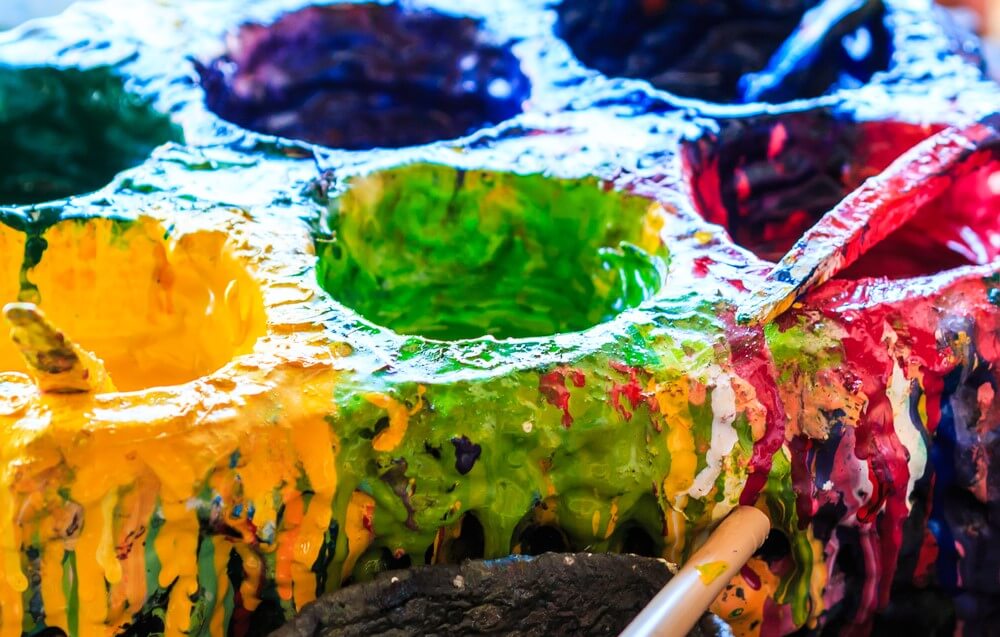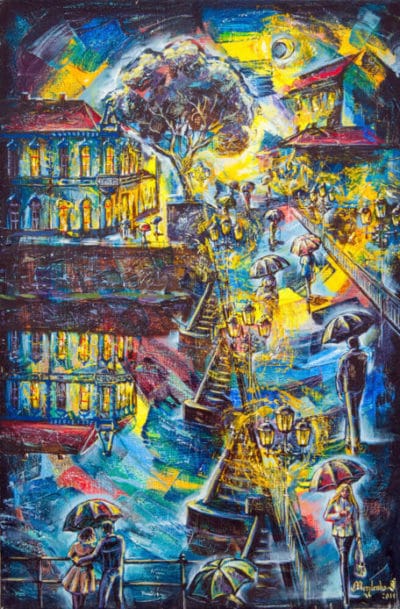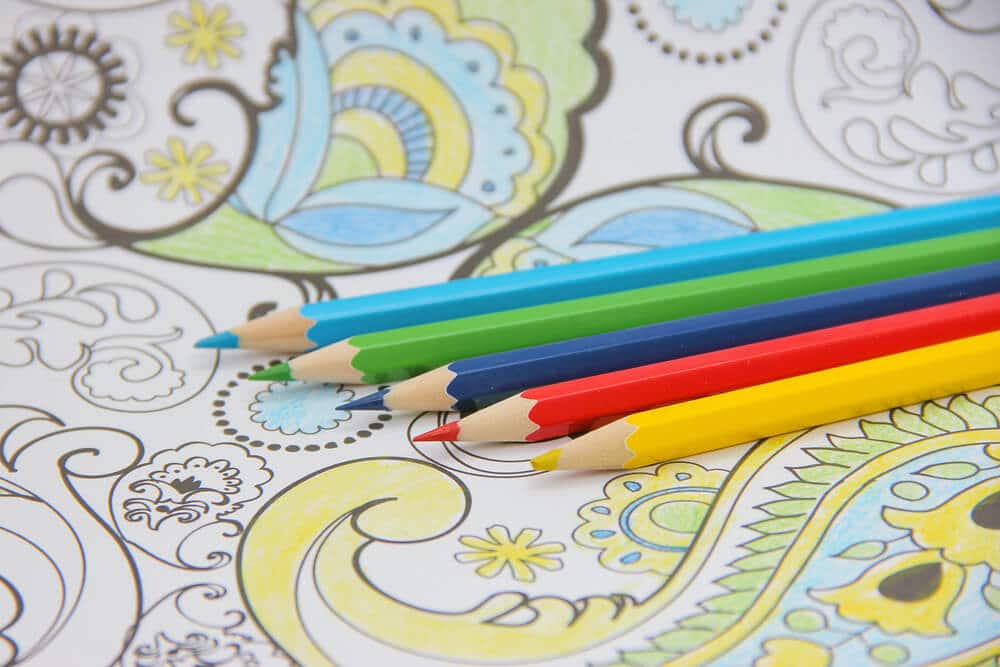Reestablishing basic mental order through beauty is something art therapy prides itself in as a discipline. No matter how insecure and clouded a person’s mental health may be, art can help stabilize receptors, calm sensory perceptions, and induce deep thoughts about the self and the world around it.
The unconscious is a dense shrubbery where feelings good and bad, thoughts positive and negative mix in a maze of uncertainty. Thankfully, there are doors to the sides that offer spots of shelter, exits, and trails out of the hazy road of mental disorder. Through therapy, mental health can be improved. Through art therapy, the mind is encouraged to mend itself – creating calm refuges from disruptive cerebral pathways and thoughts.

A watercolor painting of Paris will always help a troubled mind find its peace.
The following article will go through the intricacies of art therapy. We will be talking about the procedures involved in the complex process to relight one’s conscious apparatus. The mind can be both a wonder and a wondrous thing – exploring it through art is one of the simplest yet most rewarding methods to unravel its mysteries and improve sense.
What Is Art Therapy?
A discipline tasked with finding beauty, art therapy encourages mental health patients to express their thoughts and emotions through the conduct of art. Be it painting, sculpture, pottery, or even music and literature, art knows no boundaries and so nothing is excluded from the world of art therapy.
There are two types of art therapy: the one that focuses on the artistic expression and the one that focuses on the feelings expressed by a person through their artistic endeavors. The first implies that the therapist works closely with the person with mental disorder in order to create art. The second, firmly rooted in psychoanalysis, implies a person drawing several predefined patterns which are then analyzed by the therapist.
This psychoanalytic method was the first form of art therapy. However, through the decades since its inception, it has evolved beyond the limitations of Freudian psychoanalysis. At its base, this type of art therapy had a patient make art and the therapist make assumptions based on transference.
What is transference in art therapy? It means nitpicking the artistic display of a person (with or without a mental disorder) in order to find clues to their behavior, habits, lifestyle, thoughts, or feelings. Nowadays’ art therapy doesn’t go too much into transference, however, as it is generally assumed that the clues found may be misleading since everyone is prone to making false assumptions based on their intuition.

Color can liven up the imagination of a person dealing with a mental condition.
Art Therapy Ideas and Methods
Many of the practices of contemporary therapists are firmly rooted in art therapy. The most famous of these is actually split into three parts which psychologists tend to use to perform distinct tests:
- Tree drawing personality test. In which a person is tasked with drawing a tree. Depending on the peculiarities of the tree, a therapist will interpret the person’s state of mind through transference. The tree is generally seen a symbol of the self.
- Drawings of houses personality test. In which a person is tasked with drawing a house. The house may vary wildly between test subjects and may thus hint at very hidden personality traits. Houses represent a person’s inner circle, be it family, friends, or both.
- Person drawing personality test. Drawing a person can often be a very challenging task for anyone, let alone for one suffering from a mental condition. The person, sometimes gendered, represents how the subjects see the Other and thus is important for those suffering from social anxiety or those targeted by hate-speech or discriminated against.
The three tests above together constitute the house-tree-person test, also known as the HTP test. Unfortunately, the HTP test is unreliable as a single drawing can get multiple analytical solutions from multiple therapists. Therefore, it’s best to take this approach with a grain of salt – enlightening but in no way a perfect painting of a mental health patient’s feelings.

Art is a refuge of beauty that can outshine even the darkest moments in our life.
Other types of art therapy may include:
- Creating a journal. Documenting one’s daily self means having to sift through the bundle of emotions, actions, and decisions that defined it. This method of dealing with mental disorders has been around for centuries.
- Writing postcards. Postcards are ideal pieces of paper where one gets to express his or her feeling as succinctly as possible. These postcards do not need to be sent, although one’s therapist might want to read them, provided they are given permission.
- Creating a sculpture of the family. One of the consistent pictures in one’s worldview is the family he or she is from. Close relatives and loved ones make up the fabric of our daily selves – bits and pieces of personality traits compile into our own individuality. Therefore, the way we see our dear ones can be seen as a more complicated self-portrait.

- Filling in empty dialogue boxes. Comics are not just pop-culture, they are novels put into images – a perfect marriage of images and words. But what if we cut out the words? The resulting blank space can be filled with whatever thoughts and dreams our minds may make up.
- Painting while listening to music. Music therapy can be equally relaxing for the mind. Furthermore, it can be stirring for the painter engrossed in creating art. A fine combination of the arts is not just therapeutic for the soul; it can enrich one’s life altogether.
- Painting outside. Imitating real life can result in fascinating displays of modern art. Taking the canvas outside on a sunny day can help alleviate feelings of social anxiety and bolster creativity to unprecedented heights.
- Taking photos and making a collage. Photography can be a safe harbor from all the noise of the world. A snapshot of a moment where everything is surprisingly still and immovable. Making a collage of photos is like compiling our thoughts and memories. Needless to say, this can be very therapeutic.
- Inventing things. Engineers are artists too, yet the fabric or their art is not as delicate as words, colors, or clay. Invention is also a way by which one may stimulate his or her thought processes, therefore allowing for improved sense and a renewed perception of the self.
- Making self-portraits. Since we were already talking about family paintings as pseudo-self-portraits, actual self-portraits. They are metaphorical windows into our minds and can showcase one’s feelings with surprisingly precise details.
- Drawing safety. Safety is interpreted by different people in different ways, especially when one is under the burden of mental disorder. In such cases, an individual may resort to finding safe places – pockets of thought where his or her consciousness is safe from negativity. Needless to say, safety can be drawn in very wild combinations and colors.
- Drawing the illness. Tackling the issue with a head-on approach and sometimes yield positive results. Depending on the condition of the patient, to be assessed by a therapist, trying to externalize the illness onto the canvas can work miracles.
- Destroying art. Some people suffering from mental disorders can feel the need to destroy – to sense the ephemeral nature of all things. Creating and then destroying art can be a productive outlet for this desire.

Crayons and coloring books pamper the imagination of a child, thus improving mental sense.
Art Therapy for Children
Kids have the wildest of imaginations and children suffering from mental issues need to be taken extra care of. Therefore, mixing play therapy and art therapy in are foolproof ways of assuring their mental health is in check.
Autistic children or children suffering from OCD, ADHD, and others need disciplined activities and constant supervision from strong role models. More than that, children need to experiment and let their imagination work its magic into whatever creative output they may come up with. Thus, art therapy plays a very significant role in their happiness. Here are some examples of art therapy that mix in a bit of play therapy in order to seem more appealing to children:
- Chalk painting. Simple chalk drawings can be good as well, but chalk paintings, which involve complex combos of colors and art, can be extremely helpful for a kid’s mental state.
- Sketching life goals. Whether written down on a piece of paper or drawn out on a canvas, the simple idea of trying to organize life goals can improve a mentally impaired child’s ability to socialize.
- Portraits of loved ones. Painting a mother or a father can make the child better realize their importance within his or her life. Whether they like it or not, they are dependent on their parents will always need them.
Improving Sense and Other Types of Therapy
In the effort to improve sensory perception, persons dealing with mental illness have to go through the works of social life every day. Art, as many bohemians will tell you, offers the best escape from the hustle bustle of routine and anchors one’s consciousness into a world enchanted. Art therapy can thus alleviate any negative thoughts and feelings. It can inspire, it can heal, and it can definitely overcome some of the angst and sorrows of living with mental disorders.
Scientific Resources
- Rubin, Judith Aron. Approaches to Art Therapy: Theory and Technique. Routledge 2016 (link).
- Malchiodi, Cathy A. Handbook of Art Therapy. The Guilford Press 2003 (link).
- Riley, Shirley. Art Therapy with Adolescents. NCBI.gov, July 2001 (link).
All photos taken from depositphotos.com.
